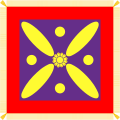List of shahanshahs of the Sasanian Empire
| "King of Kings of Iranians and non-Iranians" of the Sasanian Empire | |
|---|---|
| Šāhān šāh ī Ērān ud Anērān (Middle Persian) | |
|
Imperial
|
|

|
|

Khosrow I (531–579)
|
|
| Details | |
| First monarch | Ardashir I (224–242) |
| Last monarch | Yazdegerd III (632–651) |
| Residence |
|
The Shahanshahs of the Sasanian Empire (Middle Persian: Šāhān šāh ī Ērān ud Anērān, "King of Kings of Iranians and non-Iranians") ruled over a vast majority of land. At its height, the empire spanned from Turkey and Rhodes in the west to Pakistan in the east, and also included territory in contemporary Caucasus, Yemen, UAE, Oman, Egypt, Israel, Lebanon, Syria, Jordan and Central Asia.
The Sasanian Empire was recognized as one of the main powers in the world alongside its neighboring arch rival, the Roman-Byzantine Empire, for a period of more than 400 years. The Sasanian dynasty began with Ardashir I in 224, who was a Persian from Estakhr, and was descended from the Achaemenid Kings, and ended with Yazdegerd III in 651. The downfall of the Sasanian Empire proved of great significance and effects to Zoroastrianism, the state religion of the Sasanian Empire. The previous Zoroastrian shahanshahs were replaced with Muslim Caliphs who forced the Zoroastrians and their faith to endure harsh conditions, including the destruction of fire temples throughout the previous Sasanian Empire and marginalization of the faith.
The head of the Sasanian Empire was the shahanshah (king of kings), also simply known as the shah (king). His health and welfare was always important and the phrase “May you be immortal" was used to reply to him with. By looking on the Sasanian coins which appeared from the 6th-century and afterwards, a moon and sun is noticeable. The meaning of the moon and sun, in the words of the Iranian historian Touraj Daryaee, “suggest that the king was at the center of the world and the sun and moon revolved around him. In effect he was the “king of the four corners of the world," which was an old Mesopotamian idea." The king saw all other rulers, such as the Romans, Turks, and Chinese, as being beneath him. The king wore colorful clothes, makeup, a heavy crown, while his beard was decorated with gold. The early Sasanian kings considered themselves of divine descent; they called themselves for “bay" (divine).
...
Wikipedia
